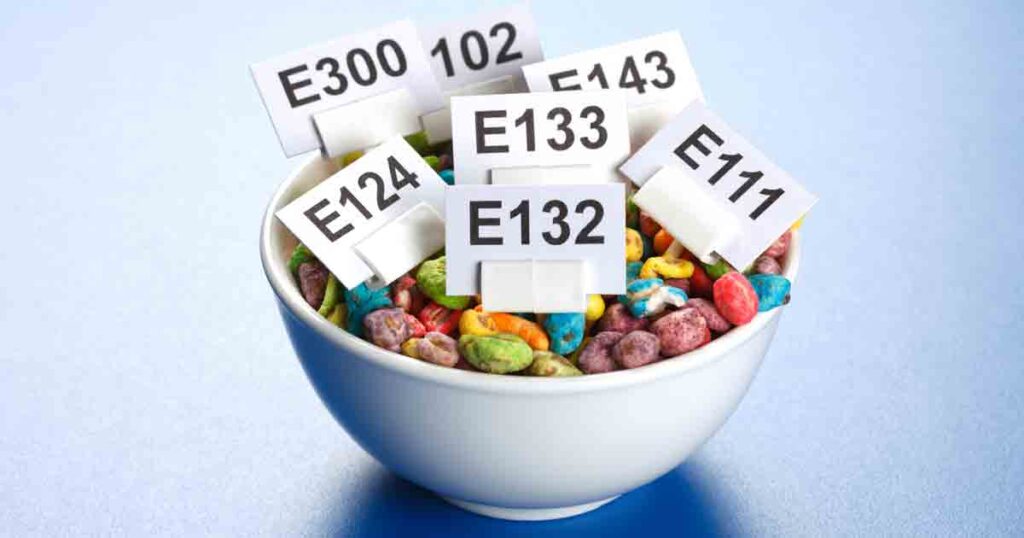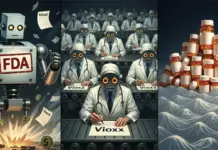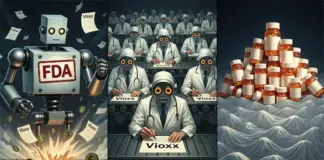
By Dr. Mercola,
STORY AT-A-GLANCE
- Nanoparticle additives in food may adversely affect your digestive tract, liver, kidney, heart and brain. They’ve also been linked to inflammation, and may “prime” you to develop disease
- Due to mounting safety concerns, France recently banned nanosized titanium dioxide in food, effective 2020. There are no regulations governing nanoparticles in food in the U.S.
- Additives are used in food processing to improve taste, texture and appearance, slow spoilage, prevent fats and oils from going rancid, prevent browning, and fortify the food with synthetic vitamins and minerals to replace the natural ones that were lost during processing
- Food testing in Switzerland found nanosized titanium dioxide, silicon oxide and talc in 27% of the food products tested
- Nanoparticles are also used in packaging, and may migrate onto the food. Nanosized silver, commonly used as an antimicrobial agent in food packaging, may kill beneficial gut bacteria and alter your gut microbiome if ingested
Processed food is the antithesis of a healthy diet for a number of different reasons, the addition of unregulated and often undisclosed chemicals being a significant one. Besides preservatives, emulsifiers, colors and flavors, which are generally listed, there are any number of others that do not have to be disclosed, as they’re considered “processing aids.”
Additives are used in food processing to slow spoilage, prevent fats and oils from going rancid, prevent browning, and fortify or enrich the food with synthetic vitamins and minerals to replace the natural ones that were lost during processing.
They’re also added to improve taste, texture and appearance, as many processed foods would be as dull and bland as cardboard without some artificial help. But despite widespread use, many food additives have questionable safety profiles, or none at all, since only a small percentage have ever been properly tested.
One such in the U.S.’s largely unregulated, group of food additives are nanoparticles, which are rapidly gaining favor in the food industry. Tests by the Adolphe Merkle Institute of the University of Fribourg and the Federal Food Safety and Veterinary Office in Switzerland found nanosized titanium dioxide, silicon oxide and talc in 27% of the food products tested.1
“This suite of ingredients, engineered to almost atomic scale, may have unintended effects on cells and organs,2 particularly the digestive tract.3
There are also indications that nanoparticles may get into the bloodstream4 and accumulate5 elsewhere in the body. They have been linked to inflammation,6 liver and kidney damage7 and even heart8 and brain damage,9” The Guardian reports in a recent article.10
NANOPARTICLES — A HIDDEN HEALTH HAZARD IN PROCESSED FOOD?
Nanoparticles have gained popularity in the food industry for their ability to “improve” the texture, appearance and flavor of food. Silicon dioxide, for example, is added to many spices and salts as an anticaking agent, meaning it allows the spices to flow easier and not clump together.
Titanium dioxide (labeled E171 in the EU), is a whitening agent used in a wide variety of products, from chocolate and chewing gum to baked goods, milk powders and mayonnaise. However, while titanium dioxide has long been considered inert, concerns about nanosized titanium dioxide have been raised for years.11
According to The Guardian,12 “the tiny metal additive has … been shown to accumulate in liver, spleen, kidney and lung tissues in rats when ingested and to damage the liver and heart muscle.”
Christine Ogilvie Hendren, executive director of the Center for the Environmental Implications of NanoTechnology at Duke University, told The Guardian that she washes “all my foods like crazy,”13 in an effort to remove surface nanoparticles.
Christine K. Payne, associate professor of mechanical engineering and materials science, Duke University, added “There might be concerns for toddlers when you have a small body mass that you’re eating a lot of these … products.”14
FRANCE BANS NANOSIZED TITANIUM DIOXIDE
Due to mounting safety concerns, France recently banned nanosized titanium dioxide in food, effective 2020. According to Reuters,15 “the country’s health and safety agency said there was not enough evidence to guarantee the safety of the substance.”
According to Payne, her studies (which are focused on the inhalation of nanomaterials) have revealed “lots of unexpected molecular and genetic effects” even at levels up to 100 times below those deemed safe by conventional toxicology tests. Payne told The Guardian:16
“What all labs [doing such research] are seeing now is that there are effects beyond toxicity, so you can work at non-toxic concentrations but still see, for example, an oxidative stress response which can lead to inflammation.”
In his safety review17 “Is Nano Safe in Foods?” published November 2017, David Julian McClements from the University of Massachusetts discusses nanoparticles’ effect on the human gastrointestinal tract, as well as some of the potential toxicity mechanisms of various food-grade nanoparticles, concluding “there is evidence that some of them could have harmful effects.”
Not all nanoparticles are added directly to the food itself. They’re also used in packaging, and may migrate onto the food. According to McClements,18 these nanoparticles may also pose health hazards. Nanosized silver, for example, commonly used as an antimicrobial agent in food packaging, may kill beneficial gut bacteria and alter your gut microbiome if ingested.
NANOSIZED TITANIUM DIOXIDE LINKED TO GUT INFLAMMATION
Research19,20 published in May 2019, found nanoparticle-sized titanium dioxide administered in drinking water impacted the gut microbiota in mice in a way that might trigger inflammatory bowel diseases and/or colorectal cancer. As explained by the authors:21
“While TiO2 [nanosized titanium dioxide] had minimal impact on the composition of the microbiota in the small intestine and colon, we found that TiO2 treatment could alter the release of bacterial metabolites in vivo and affect the spatial distribution of commensal bacteria in vitro by promoting biofilm formation.
We also found reduced expression of the colonic mucin 2 gene, a key component of the intestinal mucus layer, and increased expression of the beta defensin gene, indicating that TiO2 significantly impacts gut homeostasis.
These changes were associated with colonic inflammation, as shown by decreased crypt length, infiltration of CD8+ T cells, increased macrophages as well as increased expression of inflammatory cytokines.
These findings collectively show that TiO2 is not inert, but rather impairs gut homeostasis which may in turn prime the host for disease development.”
Associate professor Wojciech Chrzanowski, a nanotoxicology expert with the University of Sydney’s School of Pharmacy and Sydney Nano Institute, told Science Daily:22
“There is increasing evidence that continuous exposure to nanoparticles has an impact on gut microbiota composition, and since gut microbiota is a gate keeper of our health, any changes to its function have an influence on overall health.
This study presents pivotal evidence that consumption of food containing food additive E171 (titanium dioxide) affects gut microbiota as well as inflammation in the gut, which could lead to diseases such as inflammatory bowel diseases and colorectal cancer.”
NANOSIZED TITANIUM DIOXIDE ALTERS INTESTINAL HOMEOSTASIS
Another recent study23 published in the journal Environmental Science: Nano sought to determine whether nanosized titanium dioxide could affect the intestinal barrier function, the aim of which is to protect your body from external threats, if so, how.
To do that, the researchers co-cultured two types of colorectal cells to “reconstitute an in vitro mucus-secreting intestinal epithelium,” which was then exposed to three different agents: nanosized titanium dioxide, pure anatase (a mineral form of titanium dioxide), or an anatase and rutile mix (two mineral forms of titanium dioxide). As reported by the authors:24
“Two exposure scenarii were used: acute exposure for 6 h or 48 h after cell differentiation (21 days post-seeding), or repeated exposure during the course of cell differentiation, i.e., twice a week for 21 days post-seeding.
Epithelial cells repeatedly exposed to TiO2 developed an inflammatory profile, together with increased mucus secretion. Epithelial integrity was unaltered, but the content of ATP-binding cassette (ABC) family xenobiotic efflux pumps was modified.
Taken together, these data show that TiO2 moderately but significantly dysregulates several features that contribute to the protective function of the intestine.”
ALL NANOPARTICLES BIND TO GUT BACTERIA
According to a study25,26 published last year, all nanoparticles in food have the ability to bind to all types of gut bacteria, albeit to varying degrees, thereby altering the bacteria’s life cycle and activity inside your body.
While the authors suggest these characteristics may render nanoparticles usable in medicine — they could potentially be used to push the gut microbiome in a positive direction, for example — they may also cause problems. As noted in Medical News Today, which reported the team’s findings:27
“Compared with bigger particles derived from the same materials, nanoparticles have a much larger surface area relative to their size … and are able to cross biological barriers. These barriers include the mucus layer that lines tissues such as the gut.
For these reasons, their fate in the human gut is likely to differ greatly from that of larger-scale counterparts derived from the same materials. According to the study authors, ‘It is, therefore, important to ensure that any nano-enabled food ingredients are safe for application in foods’ …
A potential outcome that could be of benefit is the inhibition of infections, for example by H. pylori. The team made this discovery when experimenting with silica nanoparticles in cell cultures.
However, a potentially disturbing prospect that came up in other experiments was that binding to nanoparticles could render some unfriendly bacteria less visible to the immune system. Such a result could increase inflammation responses, for instance.”
SAFETY TESTING LAGS BEHIND IDENTIFICATION OF NOVEL INGREDIENTS
As noted in a 2018 paper28 in the journal Nanotechnology Reviews, “There is an imbalance between the increase in research to identify new nanoparticle applications and their safety …”
The authors further point out that “It has been observed that people perceive nanotechnology risks similar to genetically modified food, thus reducing the consumption of such food,” and that while “there are numerous studies on the use of nanotechnology in food and the effect of nanoparticles on human health,” few analyses of the available evidence have been performed.
In an attempt to fill this void, the authors “present and analyze different studies on the use and the safety of nanoparticles in food.” This is a good paper to read through if you want a comprehensive overview of their use and potential toxicities.
Problematically, “After years of research, we have only come to the conclusion that materials at nanoscale show drastically different properties and unexpected behavior,” the authors state, adding that “This unexpected behavior is what leads to our concerns about its toxicity.” The fourth section, “Nanotoxicity,” reads in part:29
“Nanoparticles have the unique property of increased surface area per unit volume. This renders them to behave completely different from their bulk counterparts … [N]anoparticles are more likely to react with various biological entities such as lipids and proteins or cells as a whole. Nanoparticles may cross the cell membrane entering various organs and activate inflammatory or other immune responses.
To foresee the unknown consequences of nanoparticle usage, nanotoxicological studies are performed. A typical toxicity test involves cells or organisms subjected to a specific dose of chemicals (nanoparticles, in the case of nanotoxicological studies) and measuring the response of the cells over a period of time.
The dose-response relationship from these experiments determines the optimum dose and acceptable limits for chemicals. However, unlike conventional chemicals … nanoparticles … have shapes, surface area, and surface electrical charge completely different from bulk counterparts. These might diffuse, aggregate, sediment, and change the physical and chemical properties of the media they are kept in.
The major inference that we draw is that the conventional in vitro assays may misinterpret the results and the dose-response regimes. These conventional assays do not take into account the anomalous behavior of nanoparticles in the environment and their cellular uptake.”
According to the authors, several factors can affect the toxicity of nanoparticles, including dosage, chemical reactivity, charge distribution, size and shape of the particle, and the particle’s surface area. Other influencing factors include the fact that “the interaction between the nanoparticle and the biological membrane can be either physical or chemical.”
Physical interactions between a nanoparticle and a biological membrane typically trigger “disruption of membranes and its activity, protein folding, aggregation and various transport processes,” while chemical interactions primarily result in “reactive oxygen species (ROS) generation and oxidative damage.”
Multiple exposure routes further complicate the picture when trying to identify health risks. Similarly, the route a nanoparticle uses to enter any given cell can also influence its toxic potential to the cell, as different entry routes generate greater or lesser stress.30
“The fact that their particles can distort lipid organization and overall membrane structure is an evidence in itself that the nanoparticles may affect biology as a whole,” the authors note, adding “There is an urgent need for information to better understand the nanoparticle-biological interactions and processes.”
FDA DOES NOT REGULATE NANOPARTICLES IN FOOD
While the EU has required engineered nano ingredients to be clearly indicated on the food label, no such rules exist in the U.S. When asked for a comment, the U.S. Food and Drug Administration told The Guardian31 “there are no specific provisions in the Federal Food, Drug, and Cosmetic Act that deal with nanomaterials in food.”
Many do not realize that food additives are not automatically required to get premarket approval by the FDA,32,33,34 or that items that fall under the “generally recognized as safe” (GRAS) designation are exempt from the approval process altogether.
The problem with the GRAS program is that a company can simply hire an industry insider to evaluate the chemical, and if that individual determines that the chemical meets federal safety standards, it can be deemed GRAS without any involvement from the FDA. No independent third party objective evaluation is required.35 As a result, we now have many so-called GRAS chemicals in our food supply that have never existed in the food supply before.
USED IN COMBINATION, FOOD ADDITIVE HAZARDS ARE AMPLIFIED
Adding further complexity to an already complicated picture is research showing that when you consume multiple food additives in combination, the health effects may be more serious than previously imagined.
In 2015, Denmark’s “largest research project on chemical cocktail effects in food,”36 led by the National Food Institute, concluded that even small amounts of chemicals can amplify each other’s adverse effects when combined. As reported by the Institute:
“A recently completed, four-year research project on cocktail effects in foods … has established that when two or more chemicals appear together, they often have an additive effect.
This means that cocktail effects can be predicted based on information from single chemicals, but also that small amounts of chemicals when present together can have significant negative effects.
‘Our research shows that indeed, little strokes fell great oaks also when it comes to chemical exposure. Going forward this insight has a profound impact on the way we should assess the risk posed by chemicals we are exposed to through the foods we eat,’ Professor Anne Marie Vinggaard from the National Food Institute says.”
While this research did not address nanosized additives, it stands to reason that since nanoparticles tend to be more reactive and unpredictable than their bulkier conventional counterparts, when combined with other additives — nanosized or not — the risk of toxicity may be significantly magnified.
AVOID PROCESSED FOODS TO SIDESTEP MANY POTENTIAL HAZARDS
The food industry has dramatically altered our diet, and these changes directly affect your weight and overall health. A large part of the problem stems from the processes used to manufacture the food, as food processing destroys valuable nutrients.
It also removes much of the food’s original flavor, and to address these shortcomings, synthetic nutrients, flavors, colors and other additives are used. Many of these added chemicals can wreak metabolic havoc, as your body doesn’t quite know what to do with them.
Another factor that makes processed foods the antithesis of a healthy diet is the excessive use of refined sugar and processed fructose. Virtually all processed foods contain added sugar — including commercial infant formula and baby food. Most processed foods are also loaded with genetically engineered ingredients and/or glyphosate, the most widely used herbicide in the history of agriculture.
If you’re concerned about your health, buying a good cook book and cooking from scratch using whole, organic ingredients is one of the best investments you could possibly make. For a step-by-step guide to making wiser food choices for yourself and your family, please refer to my free optimized nutrition plan.
Remember, a processed food diet sets the stage for obesity and any number of chronic health issues. In fact, many of the top diseases plaguing the United States are diet-related, including heart disease, diabetes and cancer. The answer to these health problems lies not in a pill, but, primarily, in what you eat every day.
Source: https://articles.mercola.com
Disclaimer: We at Prepare for Change (PFC) bring you information that is not offered by the mainstream news, and therefore may seem controversial. The opinions, views, statements, and/or information we present are not necessarily promoted, endorsed, espoused, or agreed to by Prepare for Change, its leadership Council, members, those who work with PFC, or those who read its content. However, they are hopefully provocative. Please use discernment! Use logical thinking, your own intuition and your own connection with Source, Spirit and Natural Laws to help you determine what is true and what is not. By sharing information and seeding dialogue, it is our goal to raise consciousness and awareness of higher truths to free us from enslavement of the matrix in this material realm.
 EN
EN FR
FR



























Who trusts the FDA? It is just another criminal organization created by the Deep State. They stand down while we are all being slowly poisoned, but try getting yourself some safe food to eat, they quickly butt in. I try to get eggs from Wisconsin where it is not mandated to chlorine wash the eggs. They actually destroy the eggs once they get to the California border. The naive ones think it is for my own safety. None of these alphabet agencies are doing things “for our safety”. That is the opposite of their agenda.